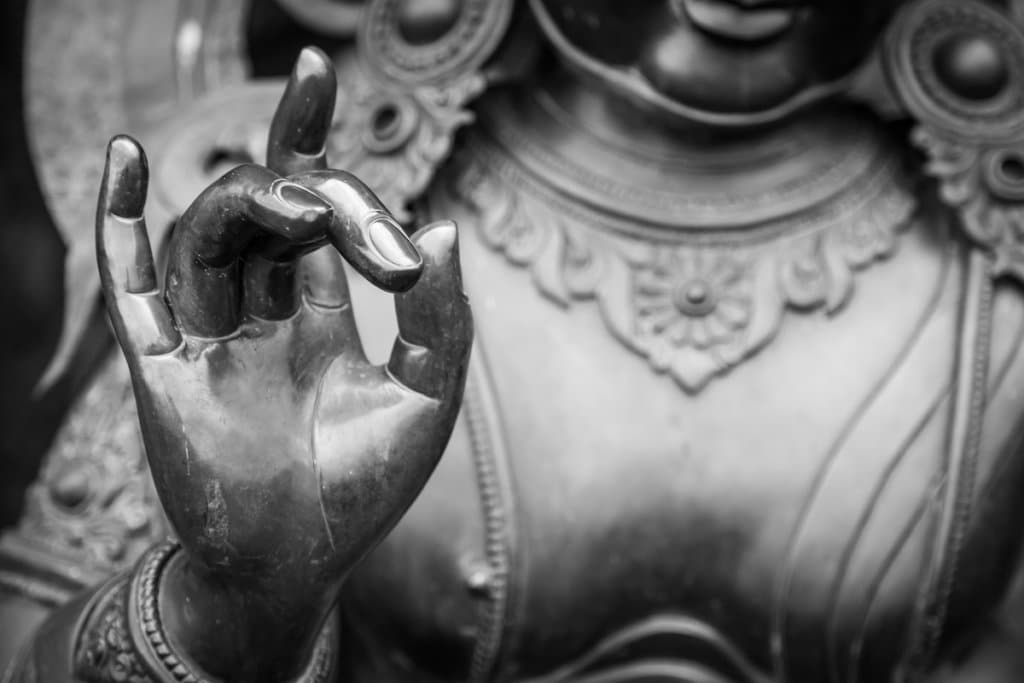Object for object, the South Asian galleries are my favorite at the Metropolitan Museum of Art. And they are always almost empty, which makes me crazy. If, as we’re often told, great art speaks for itself, with no labels or lessons needed, why aren’t these rooms packed with visitors? They are full of wondrous surprises.
At about midpoint in the long, narrow opening rooms, a hand suddenly comes into view, raised, palm forward, in your direction. Glowing under museum pin-spots, it’s honey-gold, with tapering fingers slightly parted and flexed.
The hand belongs to a splendid metal sculpture of a standing Buddha, probably cast in northern India in the early seventh century. At about 3 feet tall, it’s one of the largest images of its kind known to survive.
The gesture seems to command us to halt, in such a gentle, dancer-like way that it also soothes and beckons. Calm down, it says; come closer.
The figure itself sends complicated messages. It depicts a divinity, but one with nothing like the buffed physique of a Greco-Roman god. The Buddha’s body seems to have no muscles or bones. It’s all smooth curves, soft swells, linear rhythms.
It’s the opposite of gym-chiseled; it’s shaped by spiritual workouts.
Ancient Indian model books for artists stipulated that gods be depicted not as idealized human figures but as abstract ensembles composed of forms from nature.
Arms should evoke the smooth suppleness of vines, or an elephant’s trunk.
Eyes are compared to darting fish.
And hands to flowers.
And the ideal torso — wide shoulders, narrow waist — should suggest, in general outline, the face of a cow viewed head-on.
If Western humanism makes man the stand-alone crown of creation, the ancient Indian view of the universe, embodied in art, offers the opposite view. In it, we are the world around us, natural and divine, inseparable from it, absolutely not above it.
The Met’s great sculpture, which shows the Buddha in his earthly form, also tells the story of his life.
He was born Siddhartha Gautama in the fifth century B.C., the son of a tribal leader in what is now Nepal. He grew up in courtly luxury: The long earlobes in the Met sculpture are sometimes taken as evidence of the heavy jeweled earrings he once wore at home.
But from the start, he was restless, a questioner. Meant to be protective, palace walls felt confining. A few trips outside told him all he needed to know about reality: That life in the larger world was, whatever its momentary pleasures, about pain and loss. He knew that he was part of that world. The question was how to live with that knowledge of it.
So one night he decided to hit the road and find out. Off went the jewels, on went a simple robe, the one seen in the sculpture: light enough to be lifted by a breeze, sheer enough to hide nothing.
Tonsured like a monk, begging bowl in hand, he wandered for years, trying everything to force a breakthrough, to get to the other side of neediness. He talked to smart people, fasted, meditated and walked and walked. No relief. Anxiety ticked on. Finally, he sat under a tree and resolved to stay still until the ticking stopped.
He sat a long time, long enough for a colony of tiny snails to move up from the grass and cover his head to protect it from the sun.
When doubts and distractions bedeviled him, he grounded himself, literally, by touching the earth. Then an answer came: Banish self-centered fear; let your mind swing open.
The body language of the great Buddha speaks of openness. His lowered left hand, which holds an edge of his robe, is cupped in the shape of what could be an empty bowl.
Add to it, or take from it, as you wish.
The right hand, the active one, is raised in direct address.
It says “no worries,” though, of course, there are worries, plenty, endless, in the old but always-breaking news that nothing lasts. Nothing.
That cool six-figure job you have? That great relationship you’re in? That home? That honor? That future hope? Here today, gone tomorrow. As, by the way, are you.
For most of us, if we truly hear it, this is crushing information. The look on the Buddha’s face — a hard-to-read blend of smile and frown — tells us he understands. He’s been there.
But the response that counts, the instructive one, is in the upright hand. Larger than life (it’s way out of scale to the rest of the figure) — delicately detailed yet abstract, it says “welcome” to the world, but also “stand back.”
Holland Cotter is co-chief art critic of The New York Times.
© New York Times 2018
